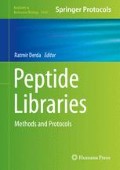Abstract
The “one-bead two-compound” (OB2C) combinatorial library is constructed on topologically segregated trifunctional bilayer beads such that each bead has a fixed cell-capturing ligand and a random library compound co-displayed on its surface and a chemical coding tag (bar code) inside the bead. An OB2C library containing thousands to millions of compounds can be synthesized and screened concurrently within a short period of time. When live cells are incubated with such OB2C libraries, every bead will be coated with a monolayer of cells. The cell membranes of the captured cells facing the bead surface are exposed to the library compounds tethered to each bead. A specific biochemical or cellular response can be detected with an appropriate reporter system. The OB2C method enables investigators to rapidly discover synthetic molecules that not only interact with cell-surface receptors but can also stimulate or inhibit downstream cell signaling. To demonstrate this powerful method, one OB2C peptide library and two OB2C peptidomimetic libraries were synthesized and screened against Molt-4 lymphoma cells to discover “death ligands.” Apoptosis of the bead-bound cells was detected with immunocytochemistry using horseradish peroxidase (HRP)-conjugated anti-cleaved caspase-3 antibody and 3,3′-diaminobenzidine as a substrate. Two novel synthetic “death ligands” against Molt-4 cells were discovered using this OB2C library approach.
Access this chapter
Tax calculation will be finalised at checkout
Purchases are for personal use only
References
Lam KS, Salmon SE, Hersh EM, Hruby VJ, Kazmierski WM, Knapp RJ (1991) A new type of synthetic peptide library for identifying ligand-binding activity. Nature 354:82–84
Furka A, Sebestyen F, Asgedom M, Dibo G (1991) General method for rapid synthesis of multicomponent peptide mixtures. Int J Pept Protein Res 37:487–493
Houghten RA, Pinilla C, Blondelle SE, Appel JR, Dooley CT, Cuervo JH (1991) Generation and use of synthetic peptide combinatorial libraries for basic research and drug discovery. Nature 354:84–86
Lam KS, Lebl M, Krchnak V (1997) The “One-Bead-One-Compound” combinatorial library method. Chem Rev 97:411–448
Aina OH, Liu R, Sutcliffe JL, Marik J, Pan CX, Lam KS (2007) From combinatorial chemistry to cancer-targeting peptides. Mol Pharm 4:631–651
Copeland GT, Miller SJ (2001) Selection of enantioselective acyl transfer catalysts from a pooled peptide library through a fluorescence-based activity assay: An approach to kinetic resolution of secondary alcohols of broad structural scope. J Am Chem Soc 123:6496–6502
Evans CA, Miller SJ (2002) Proton-activated fluorescence as a tool for simultaneous screening of combinatorial chemical reactions. Curr Opin Chem Biol 6:333–338
Tozzi C, Anfossi L, Baggiani C, Giovannoli C, Giraudi G (2003) A combinatorial approach to obtain affinity media with binding properties towards the aflatoxins. Anal Bioanal Chem 375:994–999
Kaufman DB, Hentsch ME, Baumbach GA et al (2002) Affinity purification of fibrinogen using a ligand from a peptide library. Biotechnol Bioeng 77:278–289
Meldal M, Svendsen I, Breddam K, Auzanneau FI (1994) Portion-mixing peptide libraries of quenched fluorogenic substrates for complete subsite mapping of endoprotease specificity. Proc Natl Acad Sci U S A 91:3314–3318
Lam KS, Liu R, Miyamoto S, Lehman AL, Tuscano JM (2003) Applications of one-bead one-compound combinatorial libraries and chemical microarrays in signal transduction research. Acc Chem Res 36:370–377
Peng L, Liu R, Marik J, Wang X, Takada Y, Lam KS (2006) Combinatorial chemistry identifies high-affinity peptidomimetics against alpha4beta1 integrin for in vivo tumor imaging. Nat Chem Biol 2:381–389
Xiao W, Yao N, Peng L, Liu R, Lam KS (2009) Near-infrared optical imaging in glioblastoma xenograft with ligand-targeting alpha 3 integrin. Eur J Nucl Med Mol Imaging 36:94–103
Xiao W, Wang Y, Lau EY et al (2010) The use of one-bead one-compound combinatorial library technology to discover high-affinity alphavbeta3 integrin and cancer targeting arginine-glycine-aspartic acid ligands with a built-in handle. Mol Cancer Ther 9:2714–2723
Kumaresan PR, Wang Y, Saunders M et al (2011) Rapid discovery of death ligands with one-bead-two-compound combinatorial library methods. ACS Comb Sci 13:259–264
Liu R, Marik J, Lam KS (2002) A novel peptide-based encoding system for "one-bead one-compound" peptidomimetic and small molecule combinatorial libraries. J Am Chem Soc 124:7678–7680
Kaiser E, Colescott RL, Bossinger CD, Cook PI (1970) Color test for detection of free terminal amino groups in the solid-phase synthesis of peptides. Anal Biochem 34:595–598
Liu R, Lam KS (2001) Automatic Edman microsequencing of peptides containing multiple unnatural amino acids. Anal Biochem 295:9–16
Liu R, Lam KS (2001) Structure elucidation of peptides with unnatural amino acids using an automated protein sequencer. In: Lebl M (ed) In Peptides: The wave of the future Proceedings of the Second International and the Seventeen American Peptide Symposium June 9–14, 2001. Kluwer Academic Publishers and American Peptide Society, San Diego, pp 299–300
Franz AH, Liu R, Song A, Lam KS, Lebrilla CB (2003) High-throughput one-bead-one-compound approach to peptide-encoded combinatorial libraries: MALDI-MS analysis of single TentaGel beads. J Comb Chem 5:125–137
Giudicessi SL, Gurevich-Messina JM, Martinez-Ceron MC et al (2013) Friendly strategy to prepare encoded one bead-one compound cyclic peptide library. ACS Comb Sci 15(10):525–529
Joo SH, Xiao Q, Ling Y, Gopishetty B, Pei D (2006) High-throughput sequence determination of cyclic peptide library members by partial Edman degradation/mass spectrometry. J Am Chem Soc 128:13000–13009
Wang X, Song A, Dixon S, Kurth MJ, Lam KS (2005) Facile solid phase synthesis of 1,2-disubstituted-6-nitro-1,4dihydroquinazolines using a tetrafunctional scaffold. Tetrahedron Lett 46:427–430
Acknowledgments
We would like to thank Michael Schlein for editorial assistance. This work was supported by NIH R33CA160132 and institutional fund from UC Davis.
Author information
Authors and Affiliations
Corresponding author
Editor information
Editors and Affiliations
Rights and permissions
Copyright information
© 2015 Springer Science+Business Media New York
About this protocol
Cite this protocol
Liu, R. et al. (2015). Design, Synthesis, and Application of OB2C Combinatorial Peptide and Peptidomimetic Libraries. In: Derda, R. (eds) Peptide Libraries. Methods in Molecular Biology, vol 1248. Humana Press, New York, NY. https://doi.org/10.1007/978-1-4939-2020-4_1
Download citation
DOI: https://doi.org/10.1007/978-1-4939-2020-4_1
Published:
Publisher Name: Humana Press, New York, NY
Print ISBN: 978-1-4939-2019-8
Online ISBN: 978-1-4939-2020-4
eBook Packages: Springer Protocols

